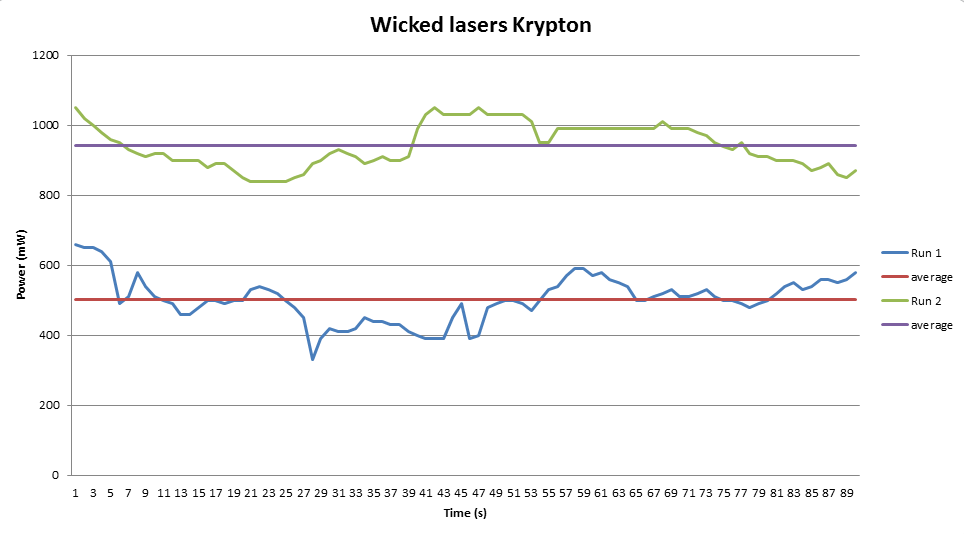SRESAL
0
- Joined
- Dec 3, 2011
- Messages
- 112
- Points
- 18
>>>SOLD<<< <1W WL Krypton ***PRICE REDUCED - $500*** (Peak 1400mW)
FOR SALE: Wicked Lasers <1000mW Krypton (with Middle Man)
Since I'm a new member here, I have asked Cyparagon to act as the middleman and he has also offered to provide extensive testing on this unit (details below).
ASKING PRICE: $500/BO - 2nd Day Air Shipping Included (FedEx)
Optical
Beam diameter at aperture: 3mm
Beam divergence: 1.9mrad (measured at 8m)
Power on low averages ~50mW with ~10mW of IR
Power on high averages ~900mW with ~20mW of IR
IR was measured with a IR-pass filter over the sensor head. This pass filter was found to have a 94% transmittance at 810nm. Every measurement yielded a different average; these are approximate averages of the averages. Output pattern has mode shifting every few seconds. The beam shape stays round, but the mode shifting causes frequent flickering.
Spectrograph of output:
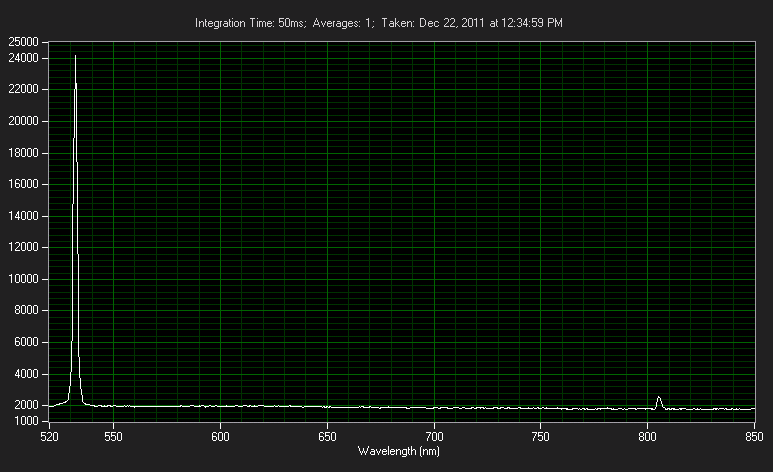
First order magnitude from diffraction (on low) grating viewed from a camera with no IR filter:
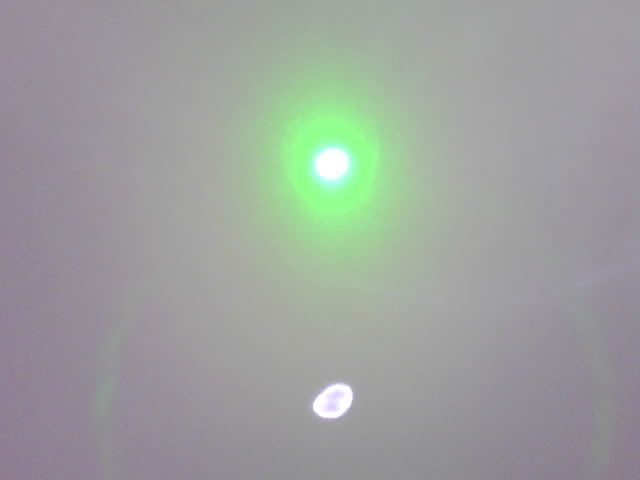
Electrical
Cutoff voltage on low: 3.3V
Cutoff voltage on high: 3.6V
Current draw from the bench supply:
Voltage set________high__________low
4.2V --------------- 1.8A ----------0.50A
4.0V --------------- 2.0A ----------0.51A
3.8V --------------- 2.3A ----------0.52A
3.6V --------------- n/a -----------0.55A
3.4V --------------- n/a -----------0.60A
Battery run-time on high for the Samsung cell sent with the arctic (measured at 2Ah) was 23.5 minutes. This means only half of the cell’s capacity was used by the driver. The open circuit voltage of the cell was 3.65V when the laser shut itself off. 2.9V or less is expected if the cell is used completely. This was done after the thermal test; the casing was kept cool to be sure the over-temp protection did not kick in.
Mechanical
This is not my area of expertise, but this requires mentioning. The finned heat sink is glued (poorly) to the assembly and slipped right off with a bit of twisting.
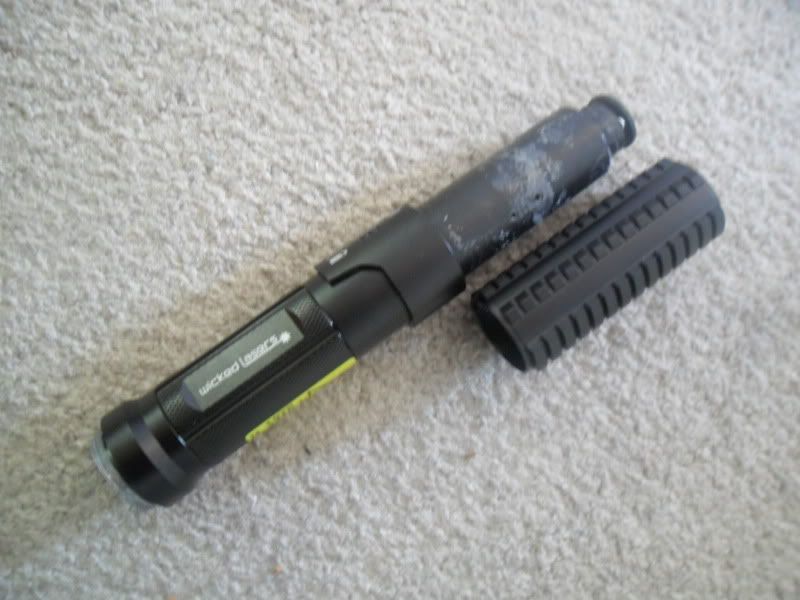
Thermal
In this test I monitored current and temperature as a function of on-time at a constant 4V output from the bench power supply. Ambient temp was 65F. Case temp started at 70F.
Time (m)______temp (F)_________Current (A)
0 --------------- 70 --------------- 1.80
5.5-------------- 80 --------------- 1.75
7.0-------------- 82 --------------- 1.65
9.5-------------- 85 --------------- 1.50
14--------------- 88 --------------- 1.35
20--------------- 91 --------------- 1.20
The driver does indeed appear to lower current with increasing temperature. This does nothing to stabilize the output; it acts as an over-temp protection. I am left wondering why the set point is so low. Anyone in a warmer climate would rarely see the full output of the laser. The components can almost surely handle substantially more than 80F. I measured the power once at the end to be 400mW.
Even though the finned heat sink is glued, the thermal resistance to it appears to be low.
Thermal profile:
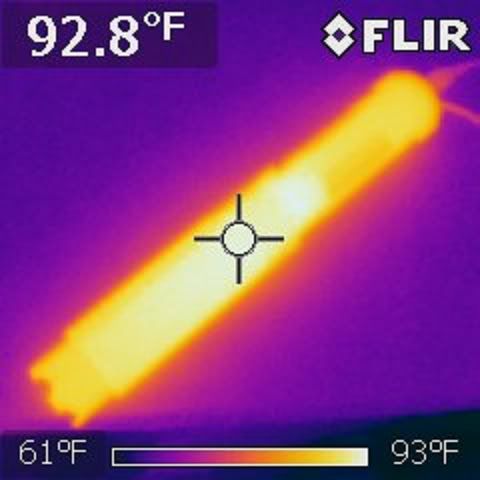
FOR SALE: Wicked Lasers <1000mW Krypton (with Middle Man)
Since I'm a new member here, I have asked Cyparagon to act as the middleman and he has also offered to provide extensive testing on this unit (details below).
ASKING PRICE: $500/BO - 2nd Day Air Shipping Included (FedEx)
<1W krypton measured stats by Cyparagon on Dec. 22 2011
Optical
Beam diameter at aperture: 3mm
Beam divergence: 1.9mrad (measured at 8m)
Power on low averages ~50mW with ~10mW of IR
Power on high averages ~900mW with ~20mW of IR
IR was measured with a IR-pass filter over the sensor head. This pass filter was found to have a 94% transmittance at 810nm. Every measurement yielded a different average; these are approximate averages of the averages. Output pattern has mode shifting every few seconds. The beam shape stays round, but the mode shifting causes frequent flickering.
Spectrograph of output:

First order magnitude from diffraction (on low) grating viewed from a camera with no IR filter:

Electrical
Cutoff voltage on low: 3.3V
Cutoff voltage on high: 3.6V
Current draw from the bench supply:
Voltage set________high__________low
4.2V --------------- 1.8A ----------0.50A
4.0V --------------- 2.0A ----------0.51A
3.8V --------------- 2.3A ----------0.52A
3.6V --------------- n/a -----------0.55A
3.4V --------------- n/a -----------0.60A
Battery run-time on high for the Samsung cell sent with the arctic (measured at 2Ah) was 23.5 minutes. This means only half of the cell’s capacity was used by the driver. The open circuit voltage of the cell was 3.65V when the laser shut itself off. 2.9V or less is expected if the cell is used completely. This was done after the thermal test; the casing was kept cool to be sure the over-temp protection did not kick in.
Mechanical
This is not my area of expertise, but this requires mentioning. The finned heat sink is glued (poorly) to the assembly and slipped right off with a bit of twisting.

Thermal
In this test I monitored current and temperature as a function of on-time at a constant 4V output from the bench power supply. Ambient temp was 65F. Case temp started at 70F.
Time (m)______temp (F)_________Current (A)
0 --------------- 70 --------------- 1.80
5.5-------------- 80 --------------- 1.75
7.0-------------- 82 --------------- 1.65
9.5-------------- 85 --------------- 1.50
14--------------- 88 --------------- 1.35
20--------------- 91 --------------- 1.20
The driver does indeed appear to lower current with increasing temperature. This does nothing to stabilize the output; it acts as an over-temp protection. I am left wondering why the set point is so low. Anyone in a warmer climate would rarely see the full output of the laser. The components can almost surely handle substantially more than 80F. I measured the power once at the end to be 400mW.
Even though the finned heat sink is glued, the thermal resistance to it appears to be low.
Thermal profile:

Last edited:




